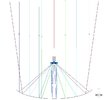Vipersan
Emmett Browns Ghost
- Joined
- Jun 29, 2009
- Messages
- 10,918
- Reaction score
- 6,663
- Points
- 113
- Age
- 66
- My Satellite Setup
-
IP9000HD +
TD110 Dish and TD88 Dish in Tandem
66°East to 60°West.
AZbox PrmHD + OpnbxS9HD + Skybox + DrHD F15
2x VboxII AZ-EL
2 m+ Alcoa PF + BSC421 C-Band lnbf...
+SS2/TwHnS2-3200 pci/TBS6925 pci
1.5 Fortec Star -Gbox - HtoH Ku/Ka/C
- My Location
- UK
Hi Friends ..
I'm Sat here trying to get a mental image of how a multiple ring flat scalar feed actually works ..
That it does is not in question ..but how ?
I fanally came to the conclusion that It works in 2 ways ..
First as a wave block and as a 'lens' of sorts ..
I have drawn a rough diagram of how I belive it functions ...but any additional info and comments would be most helpful and enlightening ..
In my diagram the red line indicates a direct beam from the bird ...which would obviously hit the back of the lnb assembly and be blocked..
The green beams indicate signal which is more direct and will be almost certainly bounced straight into the lnbs waveguide ..
The blue beams ((weaker blues to the dish extremeties - darker the closer to the centre dish 'sweat spot' ))...indicate waves which may or may not bounce directly into the guide ..but represent near miss beams which are focussed to a point outside the waveguide ..
I assume that these near miss beams are collected by the scalar rings and set up standing waves within the valleys between the rings (fequency specific for 'accept' due to the distance apart of the rings..
These standing waves eventually escape and are bounced back to the dish surface only to be relected again ...but this time relected from nearer the centre 'more focused' part of the parabola ...and therefore eventually into the waveguide of the lnb ..
For the weaker 'outer' near misses ..this may happen quite a few times ..back and forth until eventually entering the waveguide ..
Thus the rings act as a lense to focus the wanted beams/wavelengths..
Now on my diagram I've represented unwanted signals from electrical background radiation etc ..as a Brown line ..
This too will be reflected and arrive close to the lnb waveguide ...but since it is the wrong wavelength ..ie unwanted signal ...it cannot set up standing waves within the scalar ring valleys ...and therefore are not accumilated ...bounced back and forth ...and 'amplified...
Therefore these signals disperse and die ..
Those unwanted signals are effectively filtered out ..
The net effect is amplification of wanted signals and rejection of unwanted signals ..
and therefore an increase in the signal to noise ratio ..
Ok ..I'm done ...but if my crude theory is wrong ..then please would some kind soul enlighten me ...and stop me scratching a hole in my head ..
;)
rgds
VS
I'm Sat here trying to get a mental image of how a multiple ring flat scalar feed actually works ..
That it does is not in question ..but how ?
I fanally came to the conclusion that It works in 2 ways ..
First as a wave block and as a 'lens' of sorts ..
I have drawn a rough diagram of how I belive it functions ...but any additional info and comments would be most helpful and enlightening ..
In my diagram the red line indicates a direct beam from the bird ...which would obviously hit the back of the lnb assembly and be blocked..
The green beams indicate signal which is more direct and will be almost certainly bounced straight into the lnbs waveguide ..
The blue beams ((weaker blues to the dish extremeties - darker the closer to the centre dish 'sweat spot' ))...indicate waves which may or may not bounce directly into the guide ..but represent near miss beams which are focussed to a point outside the waveguide ..
I assume that these near miss beams are collected by the scalar rings and set up standing waves within the valleys between the rings (fequency specific for 'accept' due to the distance apart of the rings..
These standing waves eventually escape and are bounced back to the dish surface only to be relected again ...but this time relected from nearer the centre 'more focused' part of the parabola ...and therefore eventually into the waveguide of the lnb ..
For the weaker 'outer' near misses ..this may happen quite a few times ..back and forth until eventually entering the waveguide ..
Thus the rings act as a lense to focus the wanted beams/wavelengths..
Now on my diagram I've represented unwanted signals from electrical background radiation etc ..as a Brown line ..
This too will be reflected and arrive close to the lnb waveguide ...but since it is the wrong wavelength ..ie unwanted signal ...it cannot set up standing waves within the scalar ring valleys ...and therefore are not accumilated ...bounced back and forth ...and 'amplified...
Therefore these signals disperse and die ..
Those unwanted signals are effectively filtered out ..
The net effect is amplification of wanted signals and rejection of unwanted signals ..
and therefore an increase in the signal to noise ratio ..
Ok ..I'm done ...but if my crude theory is wrong ..then please would some kind soul enlighten me ...and stop me scratching a hole in my head ..
;)
rgds
VS

